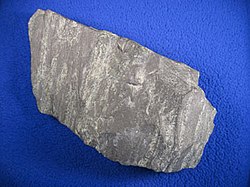Taconite
| Sedimentary iron formation rock | |
 |
|
| Composition | |
|---|---|
| Primary | Magnetite, hematite and chert |
| Secondary | Siderite, greenalite, minnesotaite and stilpnomelane |
Taconite is a variety of iron formation, an iron-bearing (> 15% iron) sedimentary rock, in which the iron minerals are interlayered with quartz, chert, or carbonate. Newton Horace Winchell, the Minnesota State Geologist, coined the term during his pioneering investigations of the Precambrian Biwabik Iron Formation of northeastern Minnesota. He noted the rock had a superficial resemblance to iron-bearing rocks from the Taconic Mountains of New York.
The iron content of taconite, commonly present as finely dispersed magnetite, is generally 25 to 30%.
In the late 19th and early 20th centuries, the United States was mining such an abundance of iron ore of high quality that taconite was considered an uneconomic waste product. By the end of World War II, however, much of the high-grade iron ore in the United States had been exhausted. Taconite became valued as a new source of the metal.
To process taconite, the ore is ground into a fine powder, the magnetite is separated from the gangue by strong magnets, and the powdered iron concentrate is combined with a binder such as bentonite clay and limestone as a flux. As a last step, it is rolled into pellets about one centimeter in diameter that contain approximately 65% iron. The pellets are fired at a very high temperatures to harden them and make them durable. This is to ensure that the blast furnace charge remains porous enough to allow heated gas to pass through and react with the pelletized ore. Firing the pellet oxidizes the magnetite (Fe3O4) to hematite (Fe2O3), an exothermic reaction that reduces the cost of pelletizing the concentrate. E. W. Davis of the University of Minnesota Mines Experiment Station is credited with developing the pelletizing process. Since the commercial development of this process in the Lake Superior region in the 1950s, the term taconite has been used globally to refer to iron ores amenable to upgrading by similar processes.
...
Wikipedia
